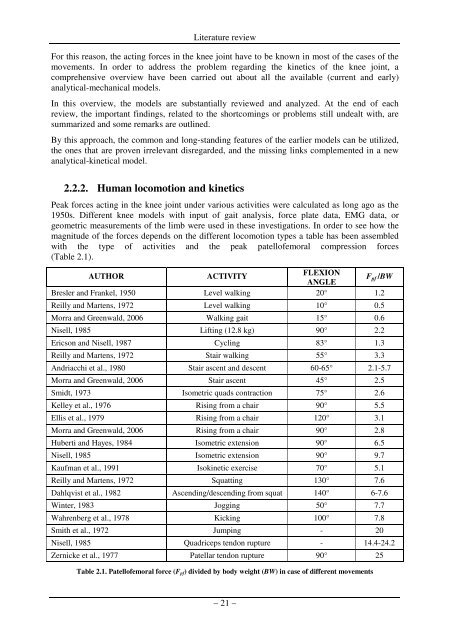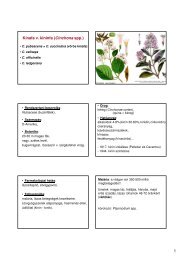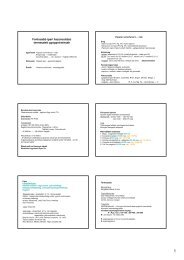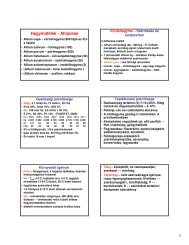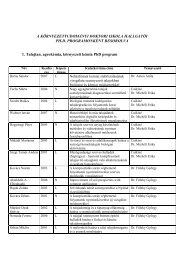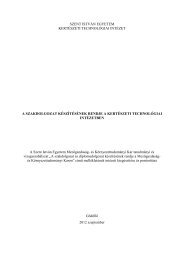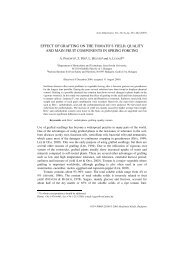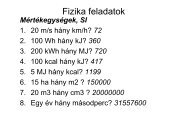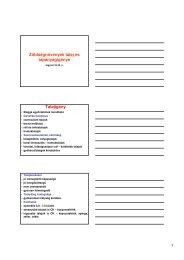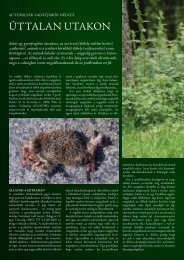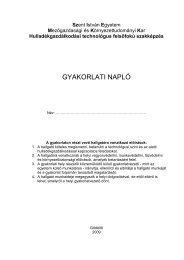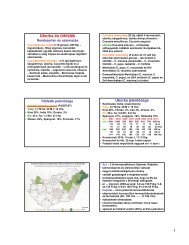PhD Fekete - SZIE version - 2.2 - Szent István Egyetem
PhD Fekete - SZIE version - 2.2 - Szent István Egyetem
PhD Fekete - SZIE version - 2.2 - Szent István Egyetem
Create successful ePaper yourself
Turn your PDF publications into a flip-book with our unique Google optimized e-Paper software.
Literature review<br />
For this reason, the acting forces in the knee joint have to be known in most of the cases of the<br />
movements. In order to address the problem regarding the kinetics of the knee joint, a<br />
comprehensive overview have been carried out about all the available (current and early)<br />
analytical-mechanical models.<br />
In this overview, the models are substantially reviewed and analyzed. At the end of each<br />
review, the important findings, related to the shortcomings or problems still undealt with, are<br />
summarized and some remarks are outlined.<br />
By this approach, the common and long-standing features of the earlier models can be utilized,<br />
the ones that are proven irrelevant disregarded, and the missing links complemented in a new<br />
analytical-kinetical model.<br />
<strong>2.2</strong>.2. Human locomotion and kinetics<br />
Peak forces acting in the knee joint under various activities were calculated as long ago as the<br />
1950s. Different knee models with input of gait analysis, force plate data, EMG data, or<br />
geometric measurements of the limb were used in these investigations. In order to see how the<br />
magnitude of the forces depends on the different locomotion types a table has been assembled<br />
with the type of activities and the peak patellofemoral compression forces<br />
(Table 2.1).<br />
AUTHOR<br />
ACTIVITY<br />
FLEXION<br />
F pf /BW<br />
ANGLE<br />
Bresler and Frankel, 1950 Level walking 20° 1.2<br />
Reilly and Martens, 1972 Level walking 10° 0.5<br />
Morra and Greenwald, 2006 Walking gait 15° 0.6<br />
Nisell, 1985 Lifting (12.8 kg) 90° <strong>2.2</strong><br />
Ericson and Nisell, 1987 Cycling 83° 1.3<br />
Reilly and Martens, 1972 Stair walking 55° 3.3<br />
Andriacchi et al., 1980 Stair ascent and descent 60-65° 2.1-5.7<br />
Morra and Greenwald, 2006 Stair ascent 45° 2.5<br />
Smidt, 1973 Isometric quads contraction 75° 2.6<br />
Kelley et al., 1976 Rising from a chair 90° 5.5<br />
Ellis et al., 1979 Rising from a chair 120° 3.1<br />
Morra and Greenwald, 2006 Rising from a chair 90° 2.8<br />
Huberti and Hayes, 1984 Isometric extension 90° 6.5<br />
Nisell, 1985 Isometric extension 90° 9.7<br />
Kaufman et al., 1991 Isokinetic exercise 70° 5.1<br />
Reilly and Martens, 1972 Squatting 130° 7.6<br />
Dahlqvist et al., 1982 Ascending/descending from squat 140° 6-7.6<br />
Winter, 1983 Jogging 50° 7.7<br />
Wahrenberg et al., 1978 Kicking 100° 7.8<br />
Smith et al., 1972 Jumping - 20<br />
Nisell, 1985 Quadriceps tendon rupture - 14.4-24.2<br />
Zernicke et al., 1977 Patellar tendon rupture 90° 25<br />
Table 2.1. Patellofemoral force (F pf) divided by body weight (BW) in case of different movements<br />
– 21 –


